REMEMBERING THE SECOND BAHÁ’Í WORLD CONGRESS

“I eagerly anticipate the day when New York will become a blessed spot from which the call to steadfastness in the Covenant of God will go forth to every part of the world, thus making that city outstanding from every point of view …” – ‘Abdu’l‑Bahá
This is my personal reminiscence, in brevity, of the Second Bahá’í World Congress that I attended while residing in Malaysia.
The year 1992 designated as the Holy Year saw the worldwide Bahá’í community observing the Centenary of the Ascension of Bahá’u’lláh, supplemented with many other significant events. The first authorized English translation of the Kitáb-i-Aqdas, the Most Holy Book was released in this year. On 28 May, the scroll bearing the Roll of Honor of the Knights of Bahá’u’lláh was deposited at the entrance door of the inner Sanctuary of the Most Holy Shrine. On 29 May representatives of the Bahá’í world believers and the Knights of Bahá’u’lláh kept vigil at the resting place of Bahá’u’lláh in commemorating the centenary of His ascension. Equally significant was the holding of the Second Bahá’í World Congress, the biggest gathering so far in Bahá’í history, in New York City from 23 to 26 November 1992 to “celebrate the Centenary of the inauguration of the Covenant of Bahá’u’lláh and to proclaim its aims and unifying power.” It was in its Riḍván message of 1991 that the Supreme Body mentioned New York as the venue of the Congress where the beloved Master revealed the implications of His station as the appointed Centre of the Covenant of Bahá’u’lláh and which city He designated as the “City of the Covenant”. The message also mentioned that while the Congress was in progress Bahá’í communities were to hold appropriate auxiliary events to magnify the purpose of the Congress.
Through the infallible guidance of the Universal House of Justice, a most suitable program was developed to take the Congress participants on a four-day spiritual journey. The Universal House of Justice had given the task of organizing the Congress in New York city to none other than the American Bahá’í Community. At the time when this pressing task was given, there was no hall large enough to accommodate the 30,000 participants who were expected to gather. The largest was the Jacob Javits Convention Centre of New York, completed in 1986, where the Congress was to take place.
ESCALATION OF EXCITEMENT
The organizers of the Congress in the USA had been communicating with the various national communities, providing regular updates on the forthcoming Congress. Having missed the spiritual joy and exhilaration of the historical First Bahá’í World Congress held in London in 1963, the new generation of believers took every effort not to miss the Second Bahá’í World Congress. Many were busy getting their leaves approved, saving or borrowing sufficient amounts of money, applying for passports and visas, and getting winter clothing as well. The United States Embassies abroad had always been very strict on ensuring that the applicants for visas to enter the USA were financially sound or had some stable jobs. Yet it was through some miracle that many believers with no financial means or stable jobs or who were unemployed were granted the needed visa, much to their surprise. In many countries, people who never dreamt of making it to the Congress were enabled by the immense mercy of Bahá’u’lláh to participate. As the days approached the excitement climaxed and the friends were phoning each other to update themselves or help each other in every possible way.
Some four days before the Congress was to start, the participants started to fly into the USA as individuals and in groups through various ports of entry. One of the delegations from Malaysia arrived into Chicago city and went to the House of Worship in Wilmette, followed by a tour of the national office, a walking distance from the Temple. The unexpected and most pleasant privilege and surprise were when they were taken to the archives in the basement of the Temple where they viewed relics of Bahá’u’lláh, and ‘Abdu’l‑Bahá, and some copies of Their Tablets, along with some original letters that the Guardian had written to the American believers.
PROCLAMATION IN THE SKY
On the evening of 22 November, the Malaysian delegation flew from Chicago to New York. As they were waiting in the departure hall at Chicago airport, many other local Bahá’ís from Chicago and believers from abroad joined them for connecting flights. It was a wonderful sight to behold with many greeting each other quite nosily with “Allah-u-Abhá”, with the ground crew not able to guess who this new race of men was. Pleasant shocks and surprises awaited them 30,000 feet above in the sky. Once all had boarded, the cabin crew became surprised to see the Bahá’ís consorting with each other with great joy and happiness. Some were wearing T-shirts bearing the words “Second Bahá’í World Congress”. One air hostess approached me and asked to this effect, “I see you people coming from different countries and yet mingle so friendly with each other. I also see the words “Second Bahá’í World Congress” on some T-shirts. What is this all about?” I gave a brief introduction to the Faith and the World Congress. As the plane landed at New York JFK International Airport the pilot made the usual announcement, “Ladies and gentlemen we have just landed in the JFK International Airport…” After a pause, the pilot made a special announcement, “We take this opportunity to welcome the members of the Bahá’í Faith from different parts of the globe to the Second Bahá’í World Congress in New York. We wish you a pleasant stay in New York and an enjoyable Congress.” There was thunderous applause from all the passengers with the cabin crew too joining them.
PERFECT GUIDANCE AND ARRANGEMENTS
Most of the participants were coming into the city for the first time, not knowing what would be in store. But the Congress organizers made the lives of the participants so easy and smooth. In each of the designated hotels, there were Bahá’í Desks manned by volunteers to assist the participants. They distributed booklets containing all the details of the Congress and other vital information. The details were so perfect that needed no further clarification. Buses shuttled from some nearby major hotels to the venue of the Congress. All those accommodated in smaller hotels were to walk to such hotels nearest to them. And after the sessions ended, they were brought back to where they boarded the buses. Group breakfasts were organized at the nearest restaurants. All routes to the restaurants, hotels and places where ancillary activities were organized in the evenings were well-detailed.
PRESS PUBLICITY
On November 22, the New York Times ran a story that read, “30,000 Baha’is from around the world are expected at the four-day gathering, which marks 100 years since the death of the Baha’i prophet, Baha’u’llah…” All newspapers and TV stations were actively zeroing in on the Congress.
EVE OF THE CONGRESS
On 22 November, the eve of the Congress, surprises awaited everyone. The participants who had arrived in New York were welcomed to gather at the New York Hilton to meet other believers. In the afternoon, Hand of the Cause of God Mr. ʻAlí-Akbar Furútan was seated on a chair in a big hall. Friends rushed to greet him, shake hands and take photos. Though he appeared very exhausted he was all smiles to see the thousands of Bahá’ís greeting him. To each of them, he asked for their countries of origin, and when told they were surprised to hear Mr. Furútan relating some growth and development of the Faith in those countries they came from.

Family of Yankee Leong, the first believer of the then Malaya with Mr. Furútan. From bottom L-R: Evelyn Ng, Dennis Chee, Doreen Tan and her husband Tan Boon Tin. Standing at the back is Lily Ng, daughter of Yankee Leong
There was also a large ballroom arranged for a family reunion. In different corners of the ballroom were posters reading “African Continent”, “Latin America”, etc. Pioneers who had gone to many parts of the world during the Ten-Year Crusade period had lost contact with their families for decades. And this was where the families met each other after decades of separation. Once both parties had identified each other there were hugging, sobbing, and crying loudly to which bystanders were also moved to tears. Some pioneers who went as youths returned as parents or grandparents, with their children and grandchildren accompanying them. It was indeed moving to see many families of mixed marriages as well.
THE CONGRESS STARTS – DAY ONE
The main sessions of the World Congress took place two hours each day at the Jacob Javits Centre. The whole Congress was broadcast to more than 50 countries worldwide. The 30,000 participants of the Congress represented the diversity of the Baháʼís from over 180 different nations.
The earth-shaking event that was to shake all souls had started. Early in the morning, the believers started to arrive in the main hall. As the Jacob Javits Centre could accommodate only 15,000 people at any time, the organizers had to run the Congress in two sessions- the morning session for 15,000 believers and the afternoon session for the same number of believers with the same program. Participants were either given yellow badges or blue badges to indicate whether they were to attend the morning or afternoon sessions. The only difference was that the morning session had some live sessions such as the official opening session that was recorded and screened in the afternoon sessions. Yet the spirit of the live events in the morning sessions was never lost out in the afternoon sessions. There was a big hall on the ground floor where the program was televised live for those in the afternoon session who arrived earlier. Children were placed there in the care of the volunteers and relatives in this same hall until the parents returned from the Congress sessions.
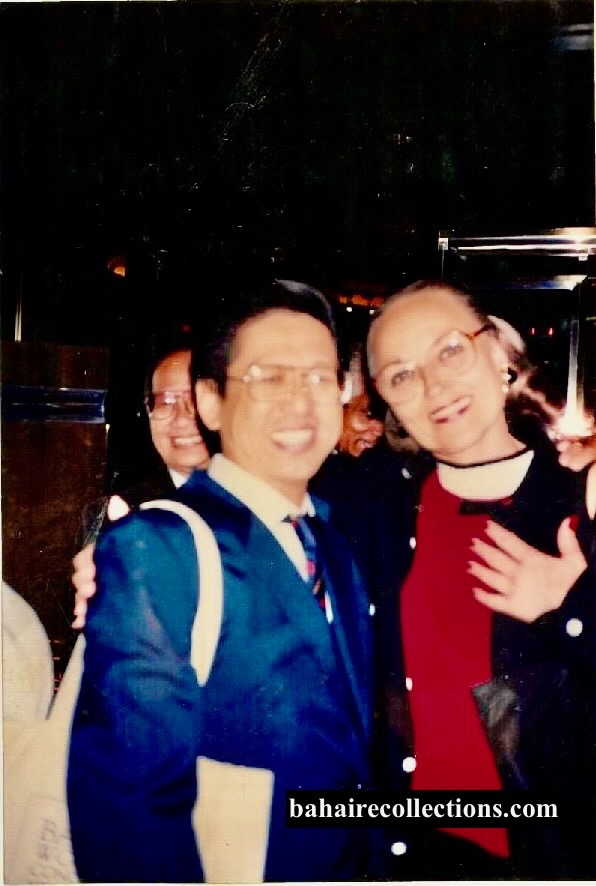
Long lost friends meet again. L-R: Chong Boo Haw of Malaysia with Mrs. Elizabeth Gibson of the USA who was in Malaysia from 1970 to 1973, serving in various capacities, including on the National Spiritual Assembly. (Photo Courtesy: N.S.S. Silan)
HEAVENS BROKE LOOSE
Inside the Javits Centre, there was the Hall of Banners, displaying some large mounted flags. Each banner was six square meters and mounted on a frame. They mentioned the name of the respective country with a Bahá’í quotation. As the participants started arriving at the hall, their eyes beheld the unbelievable- that was the largest gathering of believers from all walks of life, from the most remote to the most urban dwelling, the most literate to the most untutored, poorest to the richest and speaking different languages. That was simply a garden of flowers of all colors, where any kind of man-made prejudice had no place at all. Language was not a barrier and they found themselves very much at home. One tribal believer, Mr. William Pandawa from the most interior of Papua New Guinea was one of the centres of attraction. He had travelled by foot for one whole day to reach the nearest airstrip from where he joined twenty other delegates to the Congress. He was one of those called up to say prayers.
 Huge banners. The banner to the left is from the Penang Island community in Malaysia.
Huge banners. The banner to the left is from the Penang Island community in Malaysia.
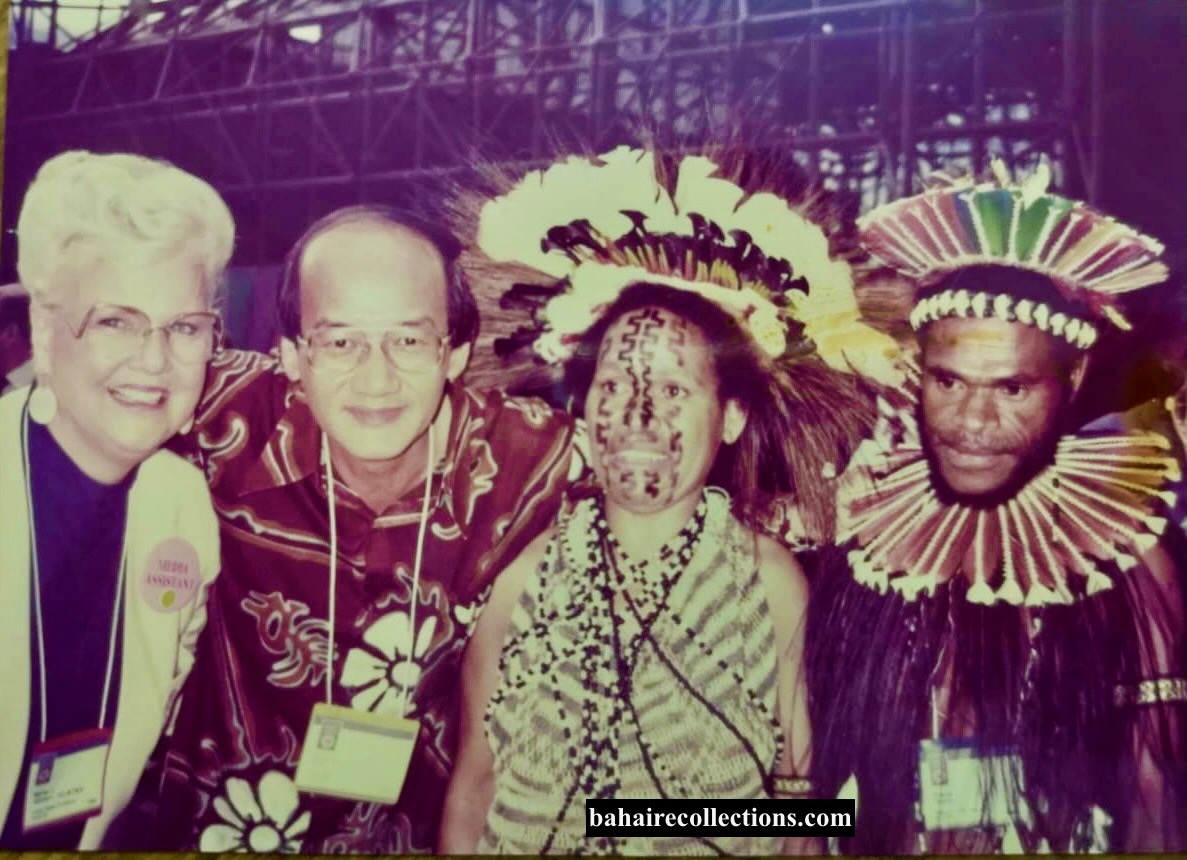
Mr. William Pandawa at the extreme right with his new friends. Second from left is Tan Boon Tin of Malaysia
For a Congress of such magnitude, some 4,000 volunteers were recruited originally. As the Congress kick-started, more volunteers were needed. New volunteers were recruited from among the participants and were lined up inside the main hall, in the large foyer hall and outside the building to ensure there was no flaw! The volunteers discharged their duties, sacrificing their own active participation. And there was heavy security at the Congress, manned by security personnel.
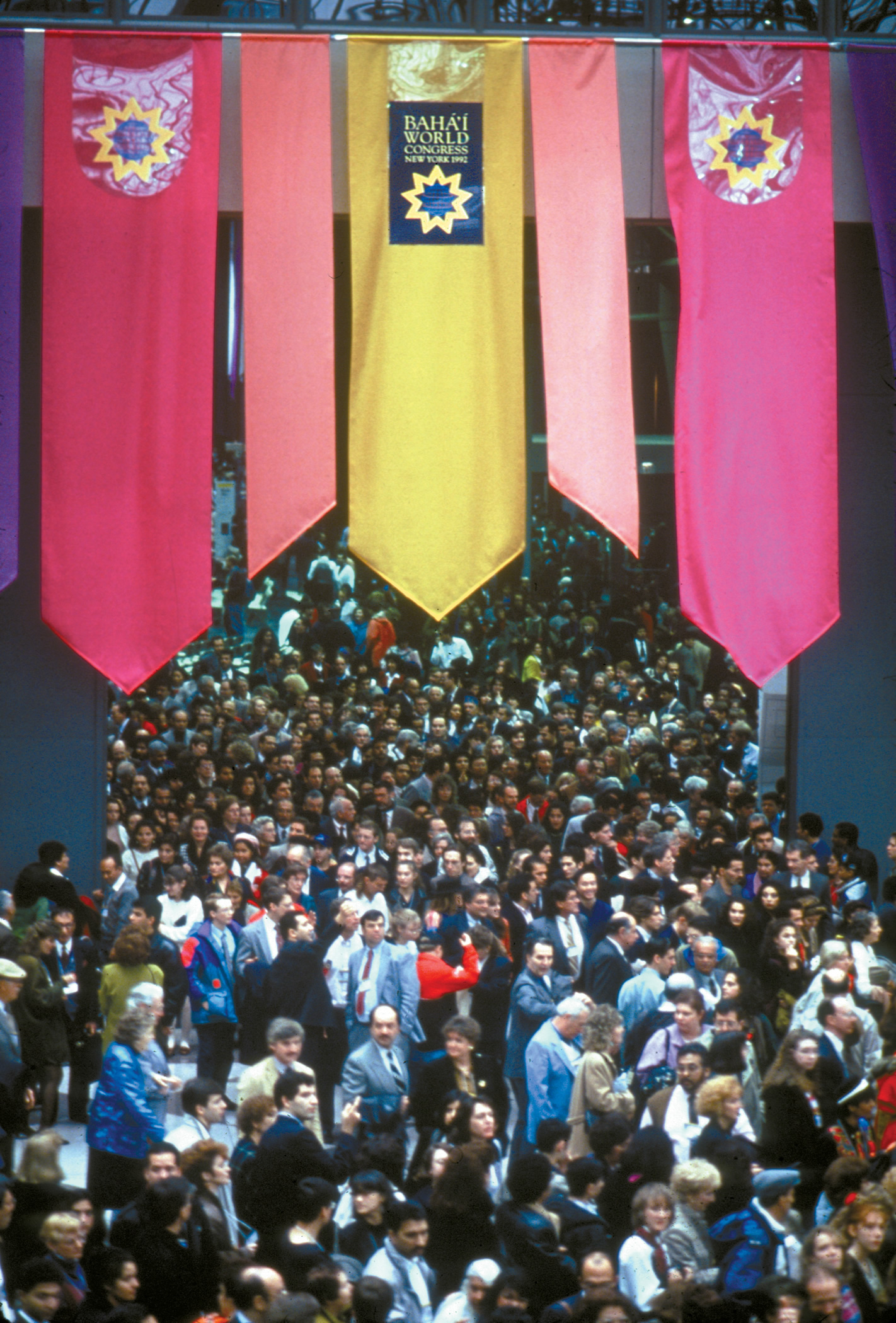
ARRIVAL AT THE MAIN HALL
As the participants entered the main hall, volunteers guided them to where to be seated. As they walked through the corridor, cameras projected them on a large screen in front of them. The audience who were already seated too viewed the screen to detect anyone known to them. Each day, as they arrived in the main hall the volunteers issued special tickets to selected participants, at random, to occupy the front row. They represented believers from different nationalities and cultural backgrounds, as reflected in their dresses. It was a theatre seating arranged in a semi-circle arrangement. There was a huge screen right at the back of the stage to project the arrival of other participants into the hall and all could see. The same screen projected speakers giving speeches given on the stage. The very arrival into the hall generated so much spirit of joy and happiness.
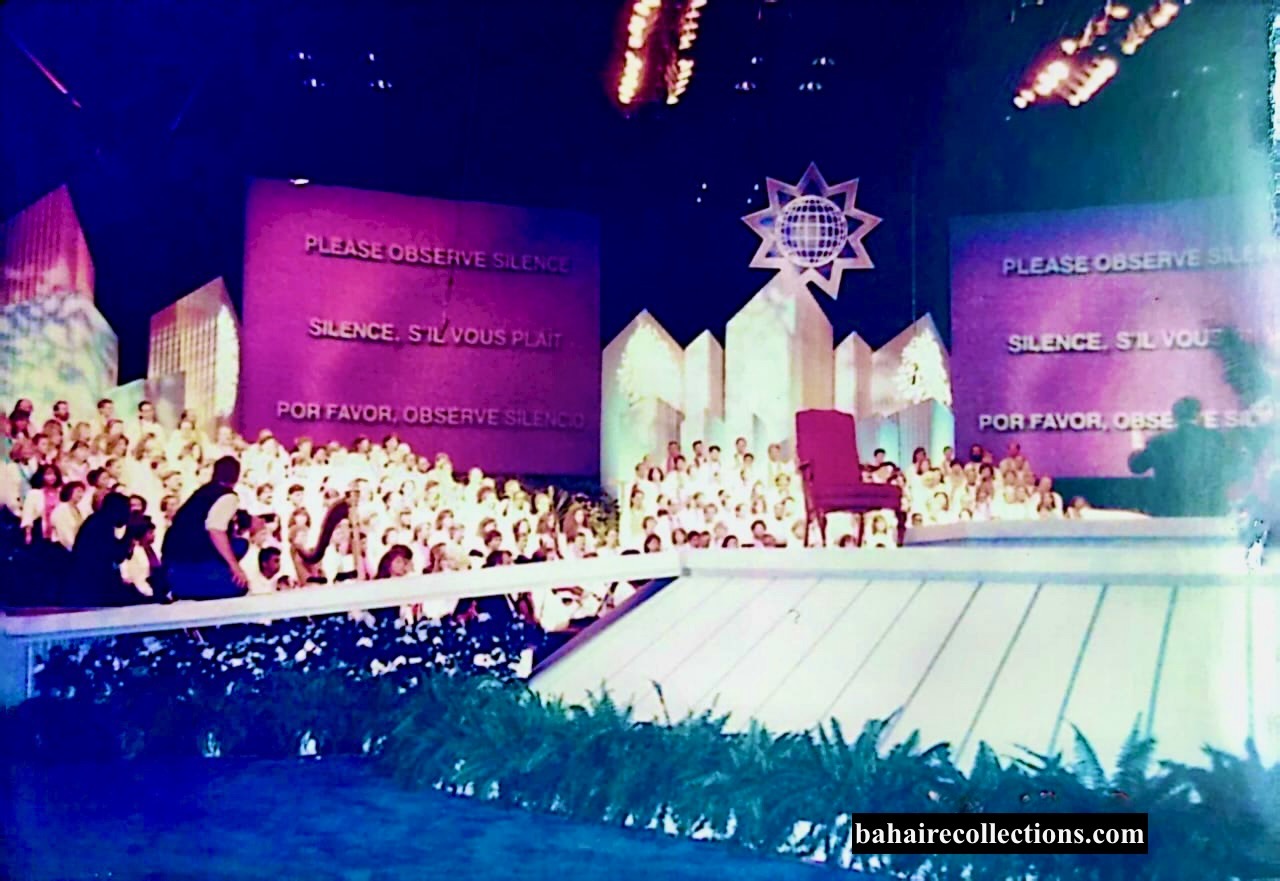
Stage with huge screens on left and right, with choir members standing between the stage and the backdrop.
MESSAGES AND GREETINGS
Just before the official opening of the Congress, a most exciting session took place. Judge James Nelson, Chairman of the National Spiritual Assembly of the Bahá’ís of the United States read the message from President George Bush. In that message the President mentioned, “I am pleased to send the greetings to the American members of the Bahá’í community and the millions of Bahá’ís around the world as you mark the 100th anniversary of the passing of Bahá’u’lláh the Prophet founder of the Bahá’í Faith…. I know that you are mindful of fellow believers who are being denied the religious freedom and tolerance that are central to Bahá’í teachings. In numerous statements and conventional resolutions, the United States has repeatedly expressed the hope that Bahá’ís in Iran, the birthplace of your Faith will be permitted to practice their religion as guaranteed by the Universal Declaration of Human Rights”. The President in the message also extolled the teachings of the Faith, “Bahá’í teachings on religious tolerance, the unity of mankind, the elimination of prejudice, equality of the sexes and universal peace, embody principles that all people of good will admire and support”. He ended, “As you salute the life and Writings of Bahá’u’lláh, I join with you in praying that we may see the realization of these fundamental principles in every land. You have my best wishes for a meaningful celebration.”
Judge George Nelson then invited and introduced David N. Dinkins, the Mayor of New York to address the Congress. In his message, the Mayor mentioned he was pleased with the Bahá’ís for selecting New York as venue for this Congress and extolled the teachings of the Bahá’í Faith and its struggles for world peace. Then he read the official proclamation from the office of the Mayor of New York. The statement recalled the visit by ‘Abdu’l‑Bahá to New York in 1912, a city which He called it the “City of the Covenant”. It further stated that people from countries throughout the world have come to USA to escape persecution and build new lives for themselves and their families. The Mayor welcomed the members of the Bahá’í Faith and said he joined them in their wish for peace and unity among all the peoples of the earth. The proclamation ended with this weighty proclamation. “Now therefore I, David Dinkins Mayor of the city of New York in recognition of this important gathering in our city do hereby proclaim Monday November 23, 1992 in the city of New York as the Bahá’í World Congress Day.”
Both the Mayor of New York and the Chairman of the National Spiritual Assembly of the Bahá’ís of USA waited for the long applause to end. When the applause ended, Judge James Nelson presented a copy of an invocation that ‘Abdu’l‑Bahárevealed in New York City during His visit in 1912 and mentioned in emphatic language that the city of New York is unique for the Bahá’ís. The Mayor, touched by that gift read the opening statement by the Master which said, “Bless Thou O King of Kings the city of New York.” The Mayor then said he would not go through the entire statement but just said “God bless all of you.”
That the President of the USA and the Mayor of New York sent so loving and so weighty greetings to the Congress, and by extension to the Bahá’í world was indeed an unexpected and most pleasant surprise, underscoring the recognition the Faith had gained at the highest levels.
OFFICIAL OPENING
Then came the official opening of the Congress for day one, with prayers offered in the various languages, by representatives from different backgrounds, who appeared in their traditional dress. The Theme of Day One concentrated on the recognition of Baha’u’llah as the Promise of All Ages. Hand of the Cause of God Amatu’l-Bahá Rúhíyyih Khánum as representative of the Universal House of Justice opened the Congress. She first conveyed the love and greetings from the Universal House of Justice, the International Teaching Centre and all serving in the World Centre. She said that the Congress was important to everyone gathered and its importance cannot be underestimated as the Faith was becoming universally recognized all over the world, with Bahá’ís living in each and every corner. Amatu’l-Bahá stated, “You couldn’t put your finger on a map of the world where there are no Bahá’ís.” She said the people, including many officials are slowly turning unto Bahá’ís and understanding what Bahá’u’lláh has brought to the world. She then read the message from the Universal House of Justice to the Congress.
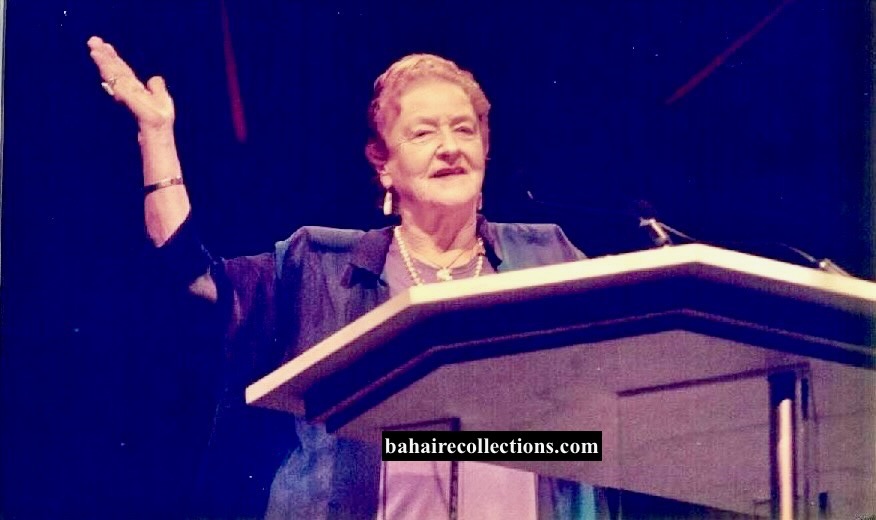 Amatu’l-Bahá at the opening session. (Photo Courtesy: N.S.S. Silan)
Amatu’l-Bahá at the opening session. (Photo Courtesy: N.S.S. Silan)
The message, among others said that so wide a diversity of the human race assembled at the Congress is in itself history-making and an impressive demonstration of the potency and potential of the Covenant as the instrument designed by the Lord of the Age for the unification and pacification of the nations and peoples of the earth. The message also paid moving tribute to the majestic figure of ‘Abdu’l‑Bahá and mentioned that in His epic journey to North America, He impressed upon the early occidental believers the pivotal importance of the Covenant; and it was in New York City that He chose to disclose to His disciples the special characteristics of that Covenant and His true station as its appointed Centre. The occasion won for this leading city of the western hemisphere the surname, City of the Covenant. It was for this reason that New York was the fitting venue for the Congress where the friends had gathered with such solemnity and spiritual joy.
FLOWERS FROM THE CRADLE
Then came the tear-jerking moment. The sacrifices by the fellow believers in Iran and the untold persecutions they went through in the past thirteen years were well remembered, with a heavy heart. While believers from different parts of the world had gathered in New York, the believers in the cradle of the Faith were deprived. But to the surprise of everyone the believers from the cradle of the Faith sent a gift of flowers to the Congress. When baskets of flowers were brought to the stage, the choir sang “Yá Bahá’u’l-Abhá!” in the most moving tone. Everyone broke down in tears. The flowers were laid below the main stage to remain throughout the Congress.
This was followed by a talk by Mr. David Hoffman, retired member of the Supreme Body who acknowledged the presence of the three Hands of the Cause, and spoke lucidly on the topic of “Bahá’u’lláh – The Promise of All Ages”.
PARADING OF THE PEOPLE OF THE WORLD
The Chairperson, looking at the sea of Bahá’ís in the gathering mentioned spontaneously that the Bahá’í Faith is most likely representing the most diverse and organized body of people on this planet. Then came the session on parading of the people of the world. Participants who were seated and dressed in their respective national costumes were quietly approached to join in the parade. They were lined up at the back of the stage from where they paraded through the crowd and finally came up the stage. They paraded to a well-read out script referring to the tribes and countries they represented and accompanied by a piece of uplifting music. The script mentioned that today, humanity in all its diversity, is representing 2000 races, tribes, and nations of the world. When all had arrived on the stage, the narrator, declared, “We are the People of the World, reflecting the great transformation of human society to one unified family.” As he said that the entire Congress raised on their feet, holding hands, and joined the choir by singing “We are the People of Bahá.”
Day One of the Congress came to an end, and everyone left the hall with radiant faces and broad smiles.
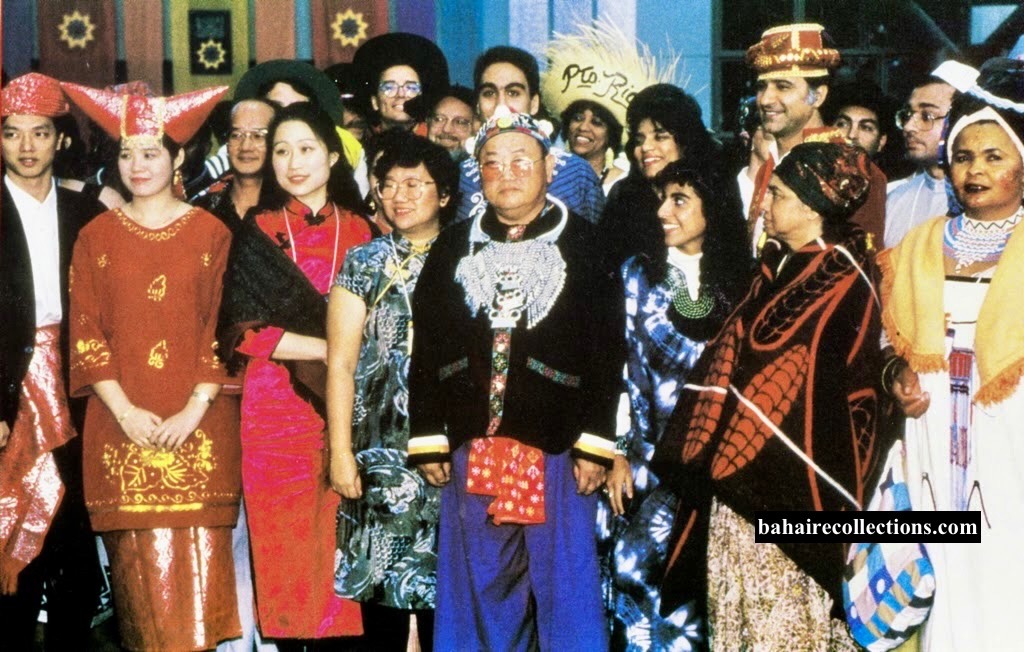
We are the People of the World
DAY TWO
Day two celebrated ‘Abdu’l-Bahá as the Centre of the Covenant The program highlighted the world-embracing nature of the Covenant, New York as the City of the Covenant, and an intimate and personal appreciation of of ‘Abdu’l-Bahá.
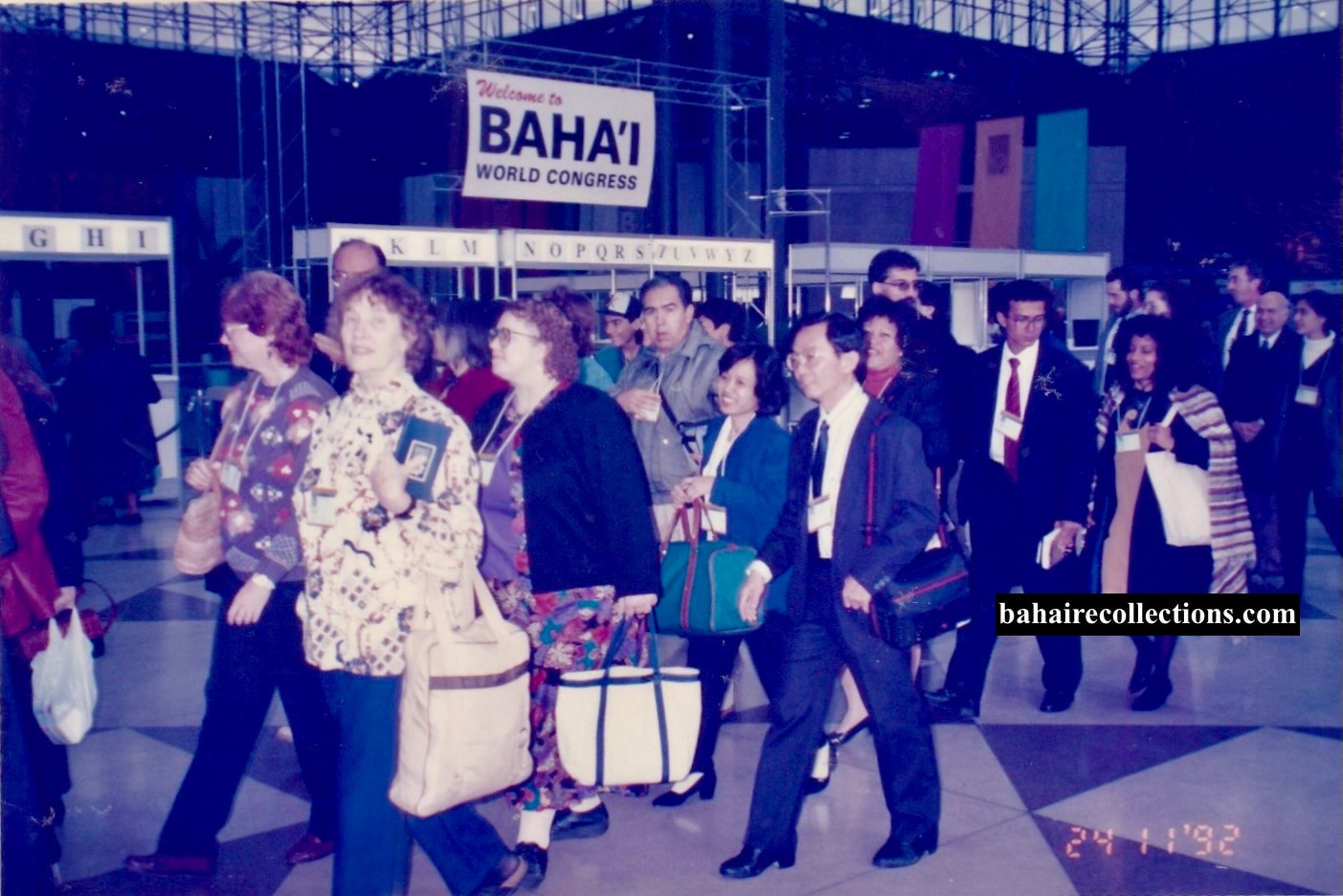 Some participants entering the Jacob Javits Centre on the second day
Some participants entering the Jacob Javits Centre on the second day
PERSONAL ENCOUNTERS WITH THE MASTER
There were brief recollections of some believers who had met the Master when He came to America in 1912. One was Mr. Shinji Yamamoto, whom the Master named Husayn. He was a Japanese who worked in the home of Mrs. Helen Goodhall in California, and had the blessing of sitting on the Master’s lap during His visit to the USA. Next was Mrs. Betty who was raised by the Master in His arms when she was still an infant. The Master had whispered something into her ears that she could not understand. She was waiting to see the Master in the next world and ask Him to repeat what He had whispered to her on earth. The third was Mrs. Sylvia Paine Parmelee, who at the age of 12 went on a Pilgrimage in 1920 and met the Master. The fourth was Mrs. Bahiyyih Randall Winckler who recollected the Master coming to her home when she was five years old. Then came Mr. Aziz Yazdi who recalled events when he lived in the household of the Master in the final three years. They all gave some vivid recollections of their personal encounter with the beloved Master, too detailed to be mentioned here. Suffice to say the believers of the future generation would not be able to get such personal recollections for obvious reason. On that account, the participants of the Congress were the privileged lot.
Then came the experiencing of historical moments by four American Bahá’ís who met the Master in 1912. They staged dramatic presentations of their personal encounters with the Master. Four believers acted out as Juliet Thompson, Lua Getsinger, Howard MacNutt and Louis Gregory. The script they memorized and spoke was very authentic as they were taken from historical documents. The theme was their struggle to remain loyal and faithful to the Covenant. In this session, the audience was truly transported to the days of the Master in America.

Aziz Yazdı who spoke on meeting the Master with his wife. (Photo courtesy: N.S.S. Silan)
SPECIAL FILM
Then came the screening of a specially produced film for the occasion, on the visit by the Master to New York city. The movie depicted the City of New York at the time of the arrival of the Master. It contained newspaper coverages as well as photos of the Master meeting some dignitaries and addressing at some important meetings. Some of the spoken words of the Master were used in this film. The audience was able to get the spirit of the time the Master visited New York in 1912.
Next came Professor and Historian Firuz Kazemzadeh from Yale University who spoke on the Master as the Centre of the Covenant of Bahá’u’lláh. That was a well-researched presentation.
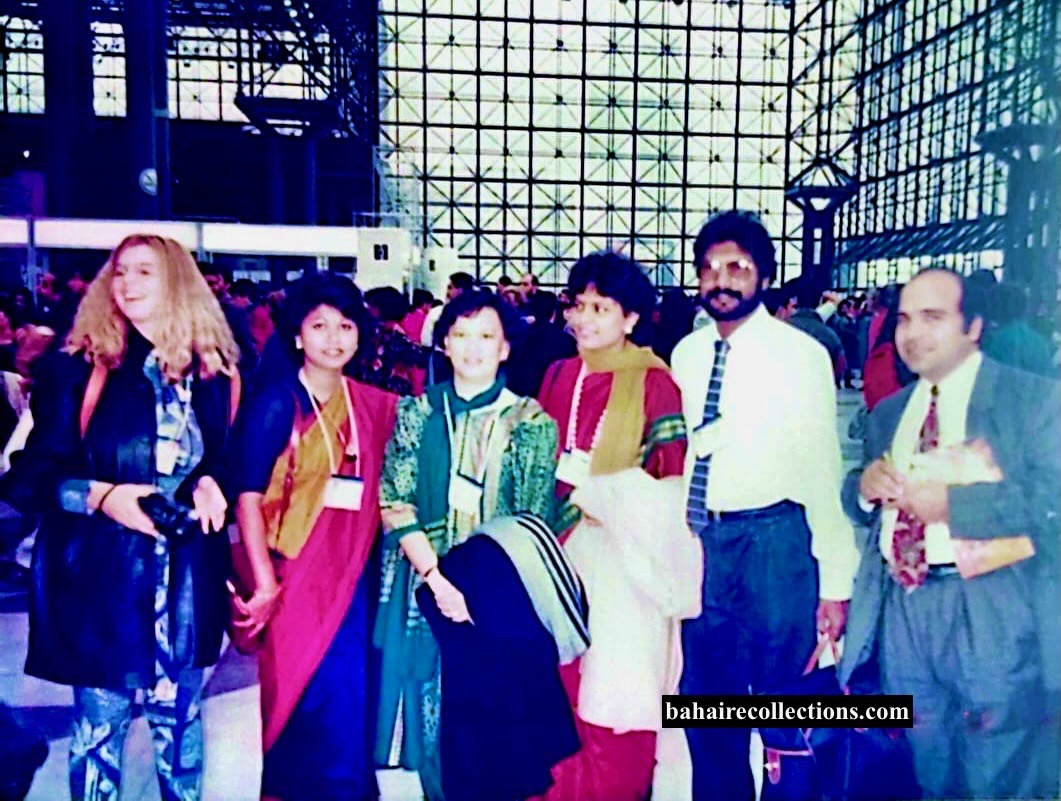 Malaysian participants flanked at both ends by participants from abroad. The Malaysian participants are L-R: Florence Thurasingam, Veronica Lim, Malini Achro and her husband Raj
Malaysian participants flanked at both ends by participants from abroad. The Malaysian participants are L-R: Florence Thurasingam, Veronica Lim, Malini Achro and her husband Raj
DAY THREE
Day three covered some achievements of the Baháʼí community with the theme “The Victories of the Covenant”.
At the first session, some believers from different countries were called upon to share their stories of the transformative power of the Faith. Mr. Juan Bejarano, a Guyamian, a tribal believer shared how the people wanted the Faith to preserve their culture when the Faith was first given to them. He spoke of the Bahá’ís, while being faithful to the Bahá’í institutions and with the blessings of the institutions were setting up, among others Radio Bahá’í, Climate Cultural Centre and children’s schools. Through such programs his people were undergoing transformation in their spiritual lives., Mrs. Janek Palta from India shared how the Indore Project, which was a Socio-Economic Development Project, had offered rural and tribal women courses on literacy, health care and income generating skills, along with application of spiritual values in their lives. Caste prejudices were much removed and the men stopped drinking alcohol. The hundreds of women then started to recognise the influence of Bahá’u’lláh in their lives. The success of this school was recognized when it won one of the Global 500 Environmental Action awards issued by the United Nations Environment Program and presented at the Earth Summit in Rio de Janeiro in 1992, equivalent to the Nobel prize for ecology. A believer from Brazil shared the unprecedented recognition given to the Faith at the Earth Summit of 1992 which was the largest gathering of heads of state and governments that had gathered for discussing the future of humanity. There gathered some 30,000 people and 12,000 Non-Governmental Organisations. On the Peace Moment were engraved the following words, “The earth is but one country and mankind its citizens”. The Chairperson of the session underscored that all these successes were attributed to obedience to the institutions and firmness in the Covenant. The audience felt so gratified that so much had been going on to emblazon the name of Bahá’u’lláh.

A tribal believer from abroad flanked by two Malaysian believers – Subramaniam on the left and Munusamy on the right.
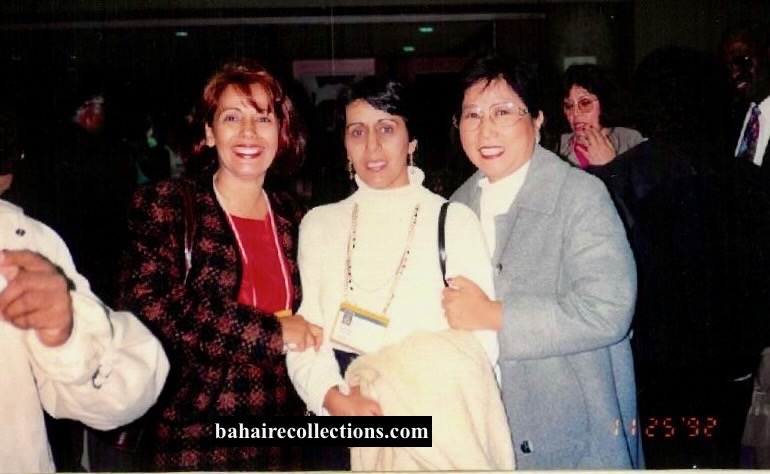
Another blissful moment. L-R: Mrs. Tahereh Silan of Australia, Mrs. Parvaneh Lee and Mrs. Lily Chinniah from Malaysia.(Photo courtesy: N.S.S.Silan)
VICTORY OF THE COVENANT
Then came the screening of the film “VICTORY OF THE COVENANT”, focusing on the unfoldment of the Tablets of the Divine Plan over the decades, followed by the fulfillment of the Ten-Year Crusade launched by the Guardian. The movie highlighted glimpses of several unprecedented victories for the Faith- 1) The establishment of the Universal House of Justice in 1963; 2) The creation of the Continental Board of Counsellors; 3) The establishment of the International Teaching Centre; 4) The acceptance of the Faith by His Highness Malietoa Tanumafili, the first head of the state of Western Samoa and the erection of the House of Worship in the Pacific; and 5) The occupation of the permanent seat of the Universal House of Justice in 1983. Then came the announcement of some statistics- where some three million had become Bahá’ís, the number of Local Spiritual Assemblies had exceeded 27,000, and Bahá’ís living in 116,000 places in the world. The movie mentioned the unfortunate arrest of the National Assembly of Iran, the outlawing of the local assemblies and the full-force persecution of the believers in Iran as well as the destruction of the House of the Báb and Bahá’u’lláh and various Bahá’í properties which collectively drew worldwide attention. The movie also highlighted that the unprecedented worldwide media coverage of the happenings in Iran had exposed the Faith to the millions with the governments coming in support of the Iranian believers, and the General Assembly of the United Nations taking up the case for the first time. With all these, the Faith clearly emerged from obscurity. The movie then highlighted that in October 1985 the Universal House of Justice published “The Promise of World Peace”. By early 1986 a total of 138 heads of state had accepted the Peace Statement. The astonishing House of Worship in New Delhi was dedicated and stood out as one of the architectural wonders of the century. The expansion of the Faith accelerated in Eastern Europe and the former republics of the Soviet Union were opened to the power of the Covenant. The Brazilian Federal Chamber of Deputies paused for a two-hour tribute to the Blessed Beauty which included the reading of a message from the Universal House of Justice. The Holy Year opened with moving ceremonies at the World Centre commemorating the Ascension of Bahá’u’lláh, with some 3,000 believers circumambulating the Shrine of Bahá’u’lláh. The Bahá’í International community was asked to address the historic Earth Summit in 1992. The influence of Bahá’u’lláh Revelation could now be felt in all spheres of human existence.
With the movie listing all these achievements and inroads for the Faith, the audience was overwhelmed with awe and wonder at the resistless and onward march of the Faith. There was a great sense of pride swelling in the hearts of one and all.
Following this film was another short film screened to show honour to the Hands of the Cause of God. This film showed photographs of the Hands appointed by Bahá’u’lláh and those referred to as Hands by ‘Abdu’l‑Bahá, as well as those appointed by the Guardian.
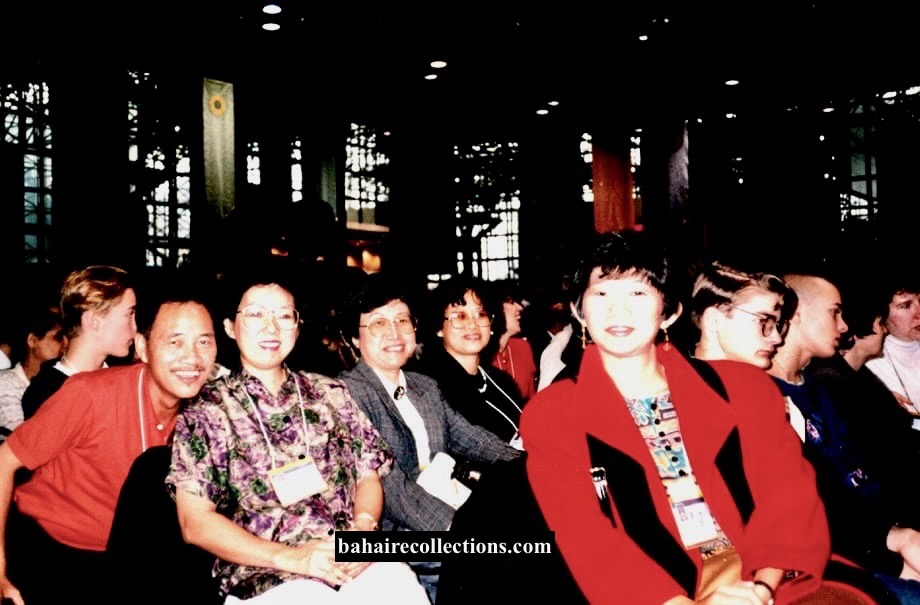
Malaysian believers inside the Congress hall. L-R: Tan Long Hock and his wife Lee Siew Hian, Mrs. Joo Jong Lum, Teresa Munusamy and Miss Ong Eng Eng.
THE THREE LIVING HANDS
Then came another equally thrilling and exciting session – address by the three living Hands of the Cause of God.
FURÚTAN
Mr. Furútan spoke about the many prophecies of the future that he had read in the Writings during his youth days and how he had seen them being fulfilled, starting with Bahá’u’lláh’s Tablet of Sultan written to Nasiruddin Shah. He recollected the First Bahá’í World Congress in 1963 and quoted the Encyclopaedia Britannica mentioning the growth of the Faith. He also mentioned about meeting the Guardian in 1941 and later in 1954. He said the Guardian mentioned in 1954 that Russia was in the dark phase and about its bright future too. The Guardian had mentioned that Mr. Furútan would go back to Russia and asked him to be patient. He was patient for sixty years in Russia. He received a letter from the Guardian in 1930 and went to Moscow to establish the Local Spiritual Assemblies. In 1991 the House of Justice asked him to go to Russia for the election of the National Spiritual Assembly. In 1992 the House of Justice asked him to go to the former Baltic states and Hungary for the election of national assemblies. Mr. Furútan said he could not believe his eyes as he was back in the very country that pushed him out! He then mentioned that whatever is revealed by the pen of Bahá’u’lláh, ‘Abdu’l‑Bahá and the Guardian will certainly be fulfilled. Mr. Furútan then stated that he was privileged to be still alive to participate in the Second World Congress which was beyond his imagination. He then urged the Bahá’ís to do a lot in the field of teaching, as Bahá’u’lláh has made teaching obligatory for all. He said he wanted to live a few more years, and when he died, he would thank Bahá’u’lláh for enabling him to see the fulfilment of whatever he had read in the Tablets.
‘ALÍ-MUHAMMAD VARQÁ
Hand of the Cause Mr. ʻAlí-Muhammad Varqá who spoke next said it was a great day for us as the city of New York reminded us of those noble days the beloved Master made His historic trip and landed in this city and showered His love upon the people here and among the Bahá’ís. He mentioned the calls the Master had made in this city. Racial prejudice was so prevalent that one hotel owner refused the Bahá’ís to hold the Day of the Covenant in the presence of the Master. But eighty years later this gathering of lovers of ‘Abdu’l‑Bahá is taking place in the same city with Bahá’ís from around the world, diversified by culture and tradition, but unified by heart, mind, and belief. The Hand of the Cause said that the invisible presence of the Master is felt in our hearts. He compared the first World Congress of 1963 to the Second World Congress to show how far we have grown today in terms of statistics. He then mentioned some statistics. He said this current growth was the outcome of the endeavour and sacrifice of the believers and there are many victories in store for the future. He said we still have a long way to go. He quoted what the Guardian had mentioned in the book Advent of Divine Justice about the future events. He urged the believers to execute the plans of the House of Justice and bring in much more excellent victories than what we have achieved before.
AMATU’L-BAHÁ
Amatu’l-Bahá said the Congress was filled up with so much emotions in which they had absorbed so much. Rather than repeating what her fellow Hands had said so clearly, she gave a few interesting anecdotes. She recollected very moving stories of some Bahá’í ladies who had created a deep impact in the history of the Faith through their sacrifices or examples they set. The essence of these stories was to demonstrate the kind of fine gems Bahá’u’lláh had created. She then mentioned about the last election of the Universal House of Justice. It was held in a big hall with many delegates from all over the world. In the back rows were some totally illiterate village Bahá’ís from Ethiopia who could not write their names. There was another bush Negro from Suriname, also illiterate. The Universal House of Justice arranged for a woman secretary to sit next to them and write the names, and they voted. She said this is the calibre of the religion to which we belong, not the twelve basic principles and all the intellectual teachings. These are the things that make this religion worthy and bring solutions to the problems of the world.
Amatu’l-Bahá then said that we today have very distinguished Bahá’ís in the midst as professors and intellectuals who add a great deal of prestige to the Faith in the estimation of the people. They are on all continents. She said they never had such people during her time. Bahá’í youth too are simply wonderful as they are exemplary in their moral behavior and arising to go teach in Russia and other countries. She said this is a marvelous development she had observed recently.
She then mentioned that Bahá’ís lack in imagination. It is we who have to live our lives and be answerable to Bahá’u’lláh. She then related an incident with Shoghi Effendi. She wanted to do something and Shoghi Effendi did not allow her to do it. He saw the disappointment on her face and told her, “You have sacrificed so much in your life. You can sacrifice this too.” She then said that we have sacrificed so much for Bahá’u’lláh and we can give more and make it a regular part of our life for the service to the Cause. Amatu’l-Bahá then said she was under the impression that she need not worry about her last breath as she was in the hands of Shoghi Effendi. But Shoghi Effendi told her in no uncertain terms, “Your destiny lies in the palm of your own hands.”
She mentioned how in the early days the cultural difficulties at times did not permit things to happen with ease. She recalled her own difficulties when adjusting to the cultures among women in Haifa. But today looking at the Congress she mentioned about the different backgrounds the participants came from- different races, different cultures, and different nations. Yet they were gathered in the hall sheltered by of the Universal House of Justice. She then urged the believers to go out of the hall and spread the teachings of Bahá’u’lláh in any way they can so that we can be worthy of having heard the name of Bahá’u’lláh. She urged the friends to go back and share with families, friends and colleagues on what they had seen at the Congress. Those were her parting words. The three Hands then appeared on the stage and posed for the Conference participants, who applauded for quite a long time.
That evening was highly educational with so many words of wisdom uttered by the three Hands of the Cause, along with other events.
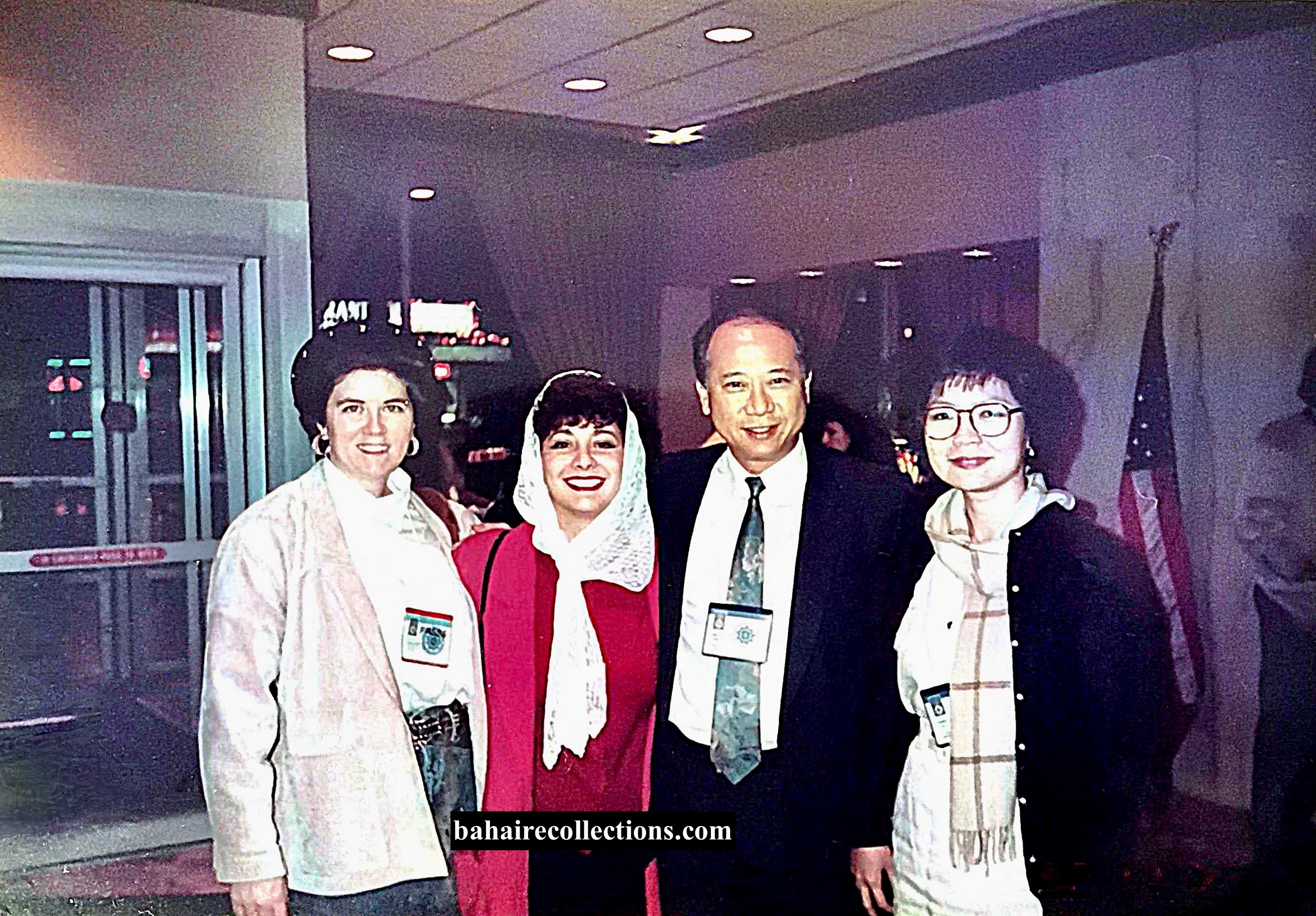 James Liew and his wife Lye Seek Luen from Malaysia at the left with new-found friends.
James Liew and his wife Lye Seek Luen from Malaysia at the left with new-found friends.
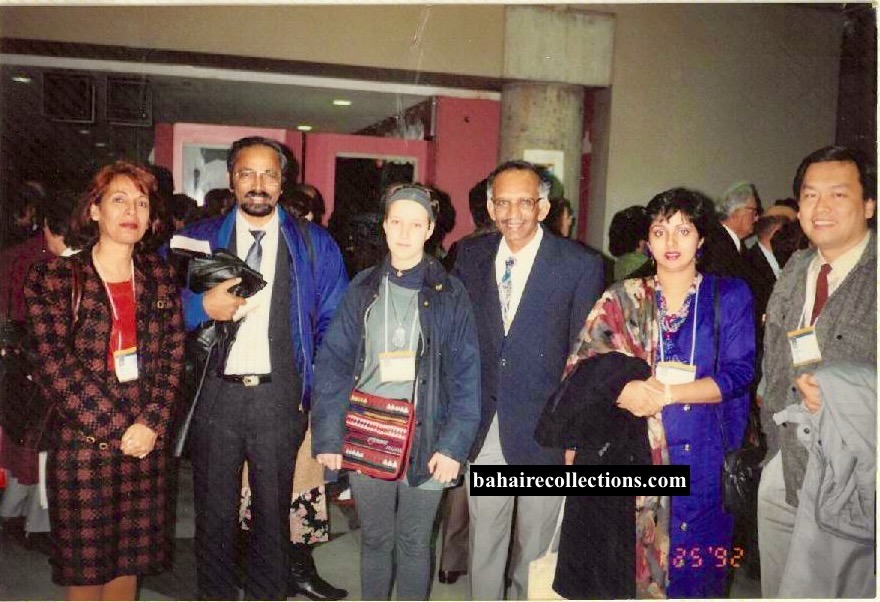 Another happy moment: L-R: Mrs. Tahereh Silan, Dr. Singaraveloo, Amelia from the UK, S. Ravichandran, Omna Ong and Bernard Ong. (Photo Courtesy: N.S.S. Silan)
Another happy moment: L-R: Mrs. Tahereh Silan, Dr. Singaraveloo, Amelia from the UK, S. Ravichandran, Omna Ong and Bernard Ong. (Photo Courtesy: N.S.S. Silan)
 Veterans of early days L-R: N.S.S. Silan, Shantha Sundram, Errol Seow Hoon Hin, Betty. (Photo Courtesy: N.S.S. Silan)
Veterans of early days L-R: N.S.S. Silan, Shantha Sundram, Errol Seow Hoon Hin, Betty. (Photo Courtesy: N.S.S. Silan)
DAY FOUR
Day four explored humanity’s encounter with Baháʼu’lláh as a prelude to the culmination of the Congress, and with a message from the Universal House of Justice.
The special arrangement for this last day ensured that the congress was not only for the 30,000 Bahá’ís gathered in New York but also for nine other conferences in different parts of the world. During the morning session, two-way satellite links were made with each of these continental conferences. The participants in New York were linked with nine other conferences held in different parts of the world through satellites placed some 22,000 miles in space. A high level of excitement was boiling among the participants in New York and those other places in the world and there was thunderous applause from all parties. The New York Congress was connected to the conference in other places starting with Apia, Western Samoa followed by Buenos Aires in Argentina, Bucharest in Romania, New Delhi in India, Moscow in Russia, Nairobi in Kenya, Panama City in Panama, Singapore city in Singapore and finally Sydney in Australia. From each of the conferences were sent greetings to the participants in New York.
MESSAGE FROM THE SUPREME BODY
New York was linked to the Holy Land where the nine members of the Supreme Body came in contact through a live broadcast. Mr. Hooper Dunbar read the message from the Supreme Body to those assembled at the New York Congress and the ancillary gatherings held in the continents. In the message, the Supreme Body felt proud for the worldwide community to have progressed amazingly since 1892, with the community now embracing the entire planet. The message pointed out that the world in its current condition had lost its bearings through the operation of forces it neither understood nor could control. But the Revelation of Bahá’u’lláh sheds new light; it refreshes our thoughts; it clarifies and expands our conception…This Covenant is the guarantee against schism; that is why those who occasionally attempt to create a cleavage in the community utterly fail in the long run…The Covenant of Bahá’u’lláh gives new meaning to humanity’s checkered history; it imparts a fresh impulse to human striving. “Like unto the artery,” ‘Abdu’l-Bahá states, it “beats and pulsates in the body of the world.”

Mrs. Kunja Balan of Malaysia is at the extreme left, with some believers from abroad.
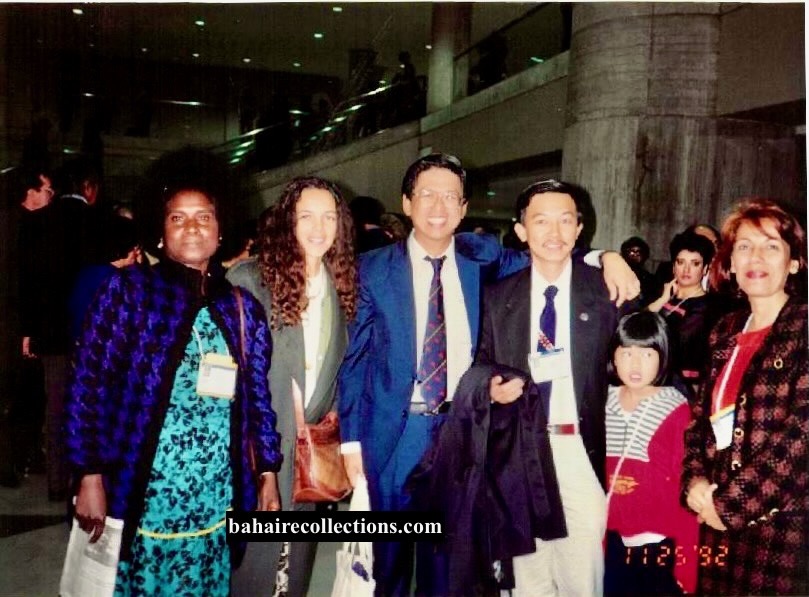
All smiles. Chong Boo Haw of Malaysia in the centre with blue coat and Mrs. Tahereh Silan at extreme right with new friends. (Photo courtesy: N.S. S. Silan)
CLOSING SESSION BY AMATU’L-BAHÁ
At the concluding session of the Congress Amatu’l-Bahá said that our hearts are very full with the wonderful message of the Supreme Body which was just read. She asked the believers to return to their homes and see if the message appears in their own newsletters in their own languages as quickly as possible. This message, she said would give the believers and institutions how to focus their attention on possible future events for mankind. On behalf of all gathered she thanked Mayor Dinkins for his warm and genuine and warm appreciation. She also mentioned that she was aware many had come to the Congress after so much sacrificial efforts, especially in light of financial constraints. She said this Faith is a religion of happiness. She recalled the words of Bahá’u’lláh spoken to professor E.G. Browne, “I desire the happiness of the nations” which is a very important and yet singularly neglected statement of Bahá’u’lláh. He did not mention the prosperity of the nations, but the happiness. Amatu’l-Bahá asked that as Bahá’ís we should carry out more of that happiness. She said the immediate future is dark but the distant future is very bright and that people have the right to listen to the Bahá’ís, as many would face in the near future all kinds of complicated deaths. She said we must talk about the immortality of the soul and we do not fear death or the future. We must talk about the great future the Bahá’ís believe in the future of the entire world.
Thus ended the Congress with the reading of the Tablet that ‘Abdu’l‑Bahá revealed in 1912 for the city of New York.
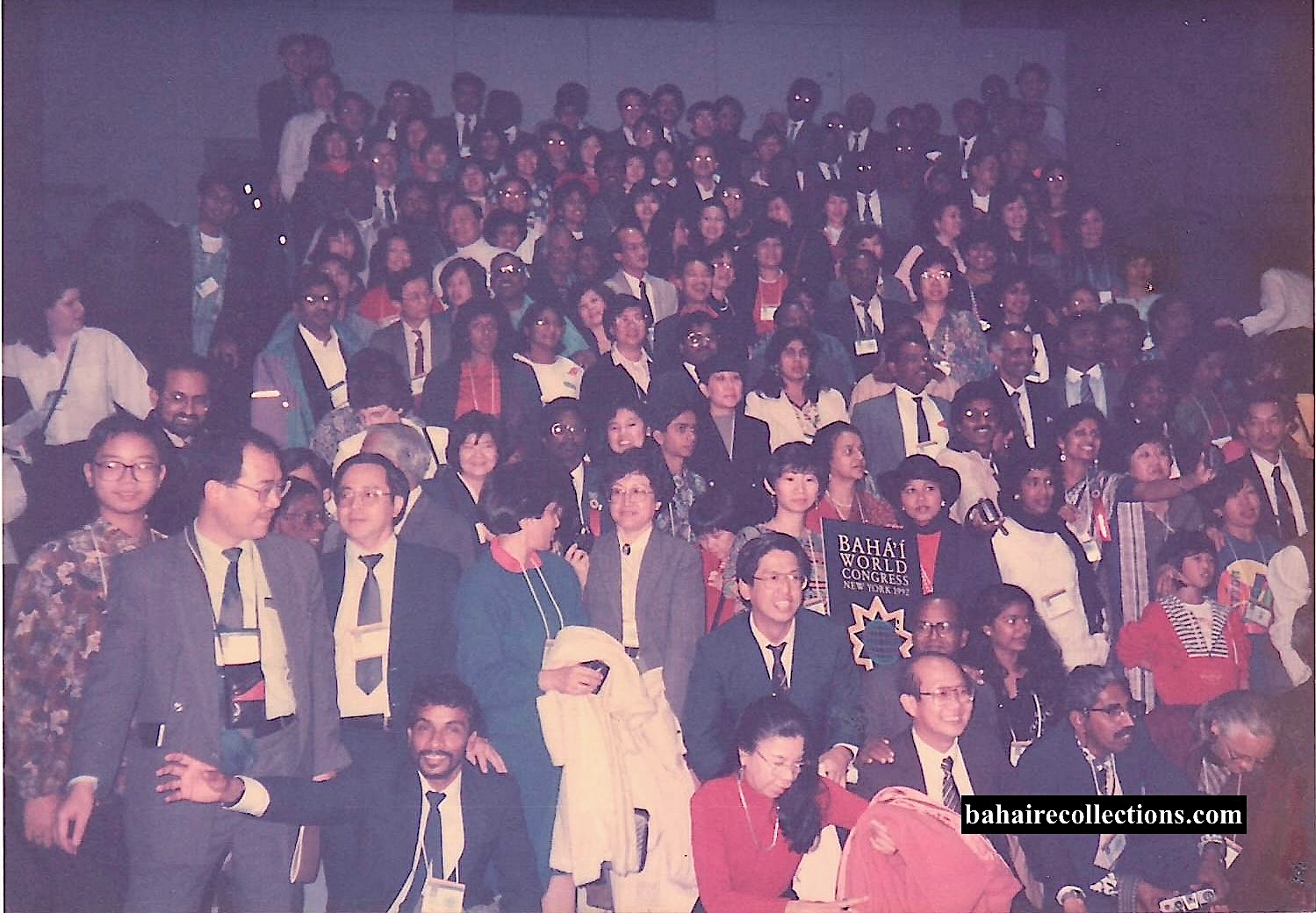 Group photo of believers from Malaysia with some other Malaysian believers who had settled in different countries
Group photo of believers from Malaysia with some other Malaysian believers who had settled in different countries
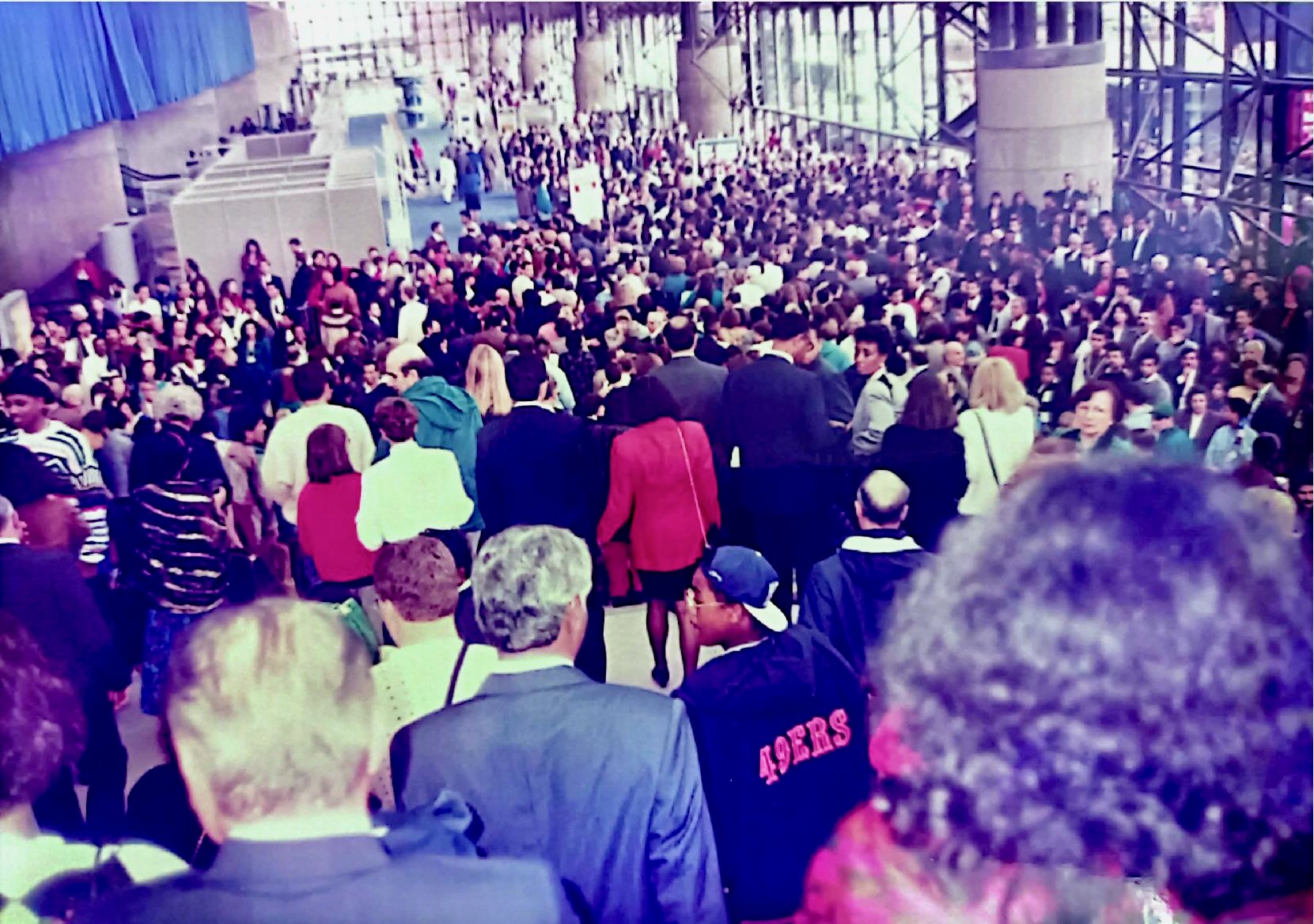
Leaving the Jacob Javits Centre on the last day.
ANCILLARY EVENTS
There were interesting ancillary events going on in the evenings in selected locations. One was the presentation of the forthcoming Arch Project coming up on Mount Carmel, with architect Fariborz Sahba making the presentation. And there were also musical presentations by the best Bahá’í musicians from across the globe. The Persian believers were most happy to play their traditional instruments. There were also artistic performances and traditional dances by more than 100 artists from around the world, with Kevin Lock as one who presented his traditional dance. Performances ranging from the deepest jungles to the most urban settings were staged with each stealing the show. The stage was for people of the world which was most distinctly represented. It was a confluence of different cultures in perfect harmony.
EXHIBITION
At the same time as the Congress there was an ongoing exhibition at the New York Hilton on the theme of “‘Abdu’l‑Bahá: Mission to America”. It was a special tribute to ‘Abdu’l‑Bahá in which the Bahá’ís were taken through a time capsule to the very real-time the Master came to America in 1912. It was open to more than a hundred dignitaries, civic and religious leaders from the Jewish, Christian and Islamic Faiths, along with reporters from around the world. Amatu’l-Bahá gave a guided tour to those dignitaries. Again, those in the morning session came here in the afternoon and those in the afternoon session came in the morning. At least five large ballrooms occupied this exhibition that had the selected writings and statements of the Master, images and photographs of His meeting with important personalities and gatherings. Nothing was left out. Everyone was totally silent as they went through the exhibition. It was simply mind-boggling to see that exhibition that had the fullest details of the visit by the Master to New York. At the end of the exhibition the group gathered around a large table on which was placed a cream-colored fez of the Master. When all had gathered, the recording of the voice of the Master reciting a prayer was played, only to move all to the very core of their hearts, with many in tears, and expressing deep gratitude to the organizers for that most unexpected spiritual treat. As they exited the exhibition there was total silence, and lost for words momentarily.
FOOD FOR THE SOUL
That music is food for the soul saw its full expression and meaning at the Congress. The songs by the choir kept filling the hall between speeches only to amplify the spirit of the Congress. Vocal music comprised of soloists and a choir of about a thousand voices from Bahá’í volunteers from all over the world. Some audio-visual segments of the program were accompanied by a highly professional symphony orchestra that accompanied the choir and soloists. What was most interesting was the selection of musical styles from different parts of the world that truly reflected the diversity and worldwide character of the Faith. It needs to be mentioned that much of the music was specifically written for the occasion. There were also songs by the various races in their own native languages. Hard work was put in by several famous Bahá’í composers such as Tom Price as well as several distinguished non-Bahá’í composers who wrote pieces for suiting specific segments of the program. The song “Look at Me, Follow Me” sung in English by Paul Seaforth and “Dastam Begir ‘Abdu’l-Bahá” in Persian by Nargis stole the show and the souls, along with songs by Dash Crofts. At one segment the chairperson was carried away that he had to say that the musical note reached a new record high-level quality. In the last singing session where the spirit soared so high, the participants were all simultaneously on their feet, holding each other’s hands and singing with them with an outburst of boundless joy
Some months after the Congress was over the music presented at the Congress in the form of Compact Discs labeled “Music from the Bahá’í World Congress – New York 1992” was then marketed all around the world.
INTERVIEWS
The Congress received much publicity from the media. As the Congress was in session, the organizers interviewed some participants who spoke in their native languages as well as English. And at the same the non-Bahá’í reporters were also interviewed. Those reporters including one from the BBC and the TASS News Agency had so many lovely things to say about the Faith and the Congress itself. Among others, the local reporters from the Daily Challenge and international reporters from the BBC were actively covering the event. Mr. Rob Weinberg from the BBC commented, “The Bahá’í World Congress is particularly interesting for the press because it has such a wide variety and diversity of people. I don’t know if there are any other events in the world where you have that broad sweep of different nations, different cultures, different nationalities different religious backgrounds coming together. I think that in itself is a new story that is unusual in the world. Newsstands do focus on violence, aggression and war and here is a real gathering of the nations of the world coming together to talk about issues which matter.”
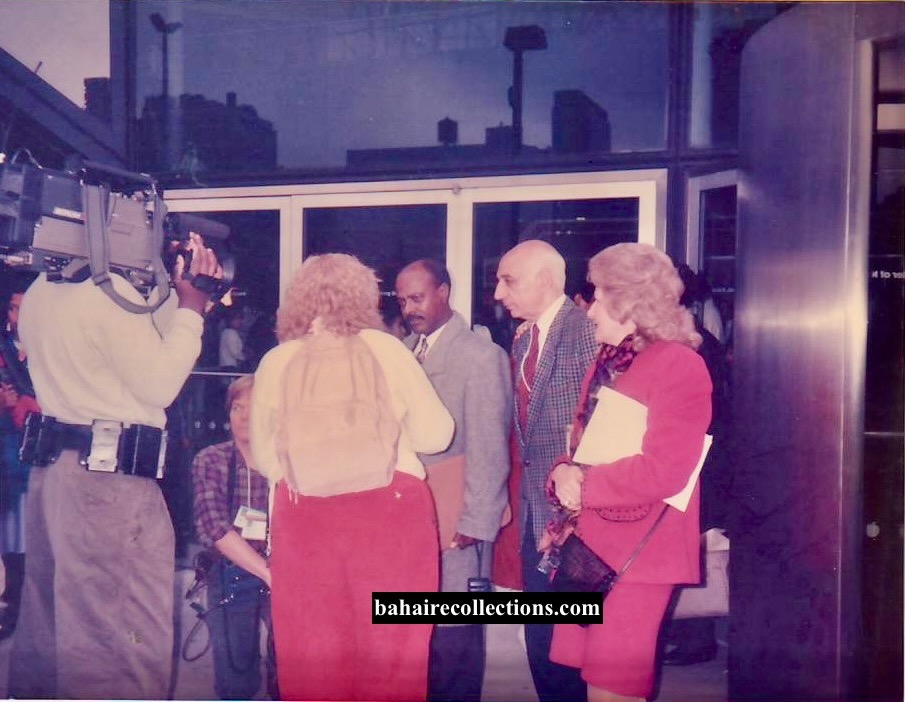
TV interviewing participants
PERIPHERALS
Since the participants were divided into two groups, those belonging to the morning session and afternoon sessions went around the city for a quick visit to some landmark places during their free time. Some in the morning session found time to fly to the House of Worship in Wilmette and yet on time for the Congress the next morning. It was during that one whole week that some 30,000 believers created impacts in ways more than one. All of them moved with badges visibly large enough for any stranger to read the words “Bahá’í World Congress”. The curious peddlers, coffee stand owners, restaurant workers, taxi drivers and those on the streets of New York received some kind of proclamation of the Faith. Some curious people approached some believers for explanation of the badges they wore which led to discussions on the Faith. One taxi driver asked a couple what the large number of people were doing in New York. The couple explained to him briefly that about the Faith which aims to bring world peace. The driver said, “No wonder I can feel some kind of peaceful atmosphere and calmness in New York. I hope you people could extend the congress days or have such events often in New York.”
Another unexpected event happened. An ice- sculptor who had read about this Congress in the papers contributed his part. He sculptured a pair of doves in ice and placed them next to the entrance of the main hall. Since it was winter, the doves made of ice remained intact till the Congress was over.
News agencies both local and abroad kept covering the event round the clock and the participants were thrilled to see the news being flashed in the dailies in New York. And when they returned to their respective countries, they were informed of the coverage of the event in their local dailies.
Participants visited a busy bookshop set up for the occasion where they purchased commemorative souvenirs such as books and T-shirts and sling bags carrying the words “Bahá’í World Congress, New York, 1992”.
“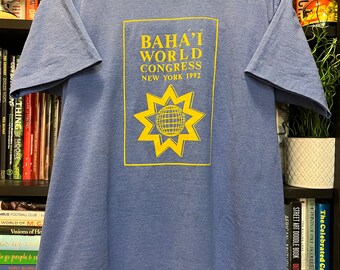
WHAT THE CONGRESS MEANT
The participants returned home with their thoughts permanently fixed on the wonders and miracles they witnessed in the City of the Covenant. Pages would not suffice to describe the Congress. To many, it meant many things in many ways. Most striking in the minds of the participants was witnessing the fulfilment of the cherished hope of the beloved Master: “I eagerly anticipate the day when New York will become a blessed spot from which the call to steadfastness in the Covenant of God will go forth to every part of the world, thus making that city outstanding from every point of view …” Each session of the Congress was moving, stirring, and striking, with no words to adequately describe the emotions that ran high. As the participants stepped out of the Jacob Javits Centre after the last session, I felt like Alice stepping out of her wonderland! To me, it was clear and manifest that the Congress events were driven into resounding success as it took place under the watchful eyes of Bahá’u’lláh. It could be everyone’s guess that the Concourse on High must have descended into that ecstatic hall. Reflecting on the showering bounties gained at the Congress, I had this invocation pulsating in my heart- “O Bahá’u’lláh! What hast Thou Done!” And I believe I was not alone. Throughout the Congress tears were welling in their eyes and rolling down their cheeks on the wonders they were witnessing – they were all tears of joy. The stories and advice from the three Hands of the Cause of God present were most touching. To many of the younger generation that was the first time they ever met any Hand of the Cause. It was at this conference that the believers had the closest encounter with the spirit of ‘Abdu’l‑Bahá, especially through the exhibition in His honour, special films on Him, speeches on Him and recollections from some who had met Him in person. The messages from the Supreme Body gave the participants direction for the future, and the needed courage to go on with life. The Congress reinforced the undeniable fact that the growth, development and recognition of the Faith have now reached an unstoppable phase. The notion by some people in the wider world that the unity of mankind as promised by Bahá’u’lláh is a utopia was completely and definitely demystified. No words of thanks could justify in appreciating the American Bahá’í community whom the Guardian had referred to as the direct descendants of the Dawn Breakers for having made the best physical arrangements- par excellence!
On reaching home the participants were happy to learn that while they were at the Congress in New York, the event was covered in both the print and electronic media in their respective countries. There were many phone calls coming in or going out on the earth-shaking event that took place in the City of the Covenant.
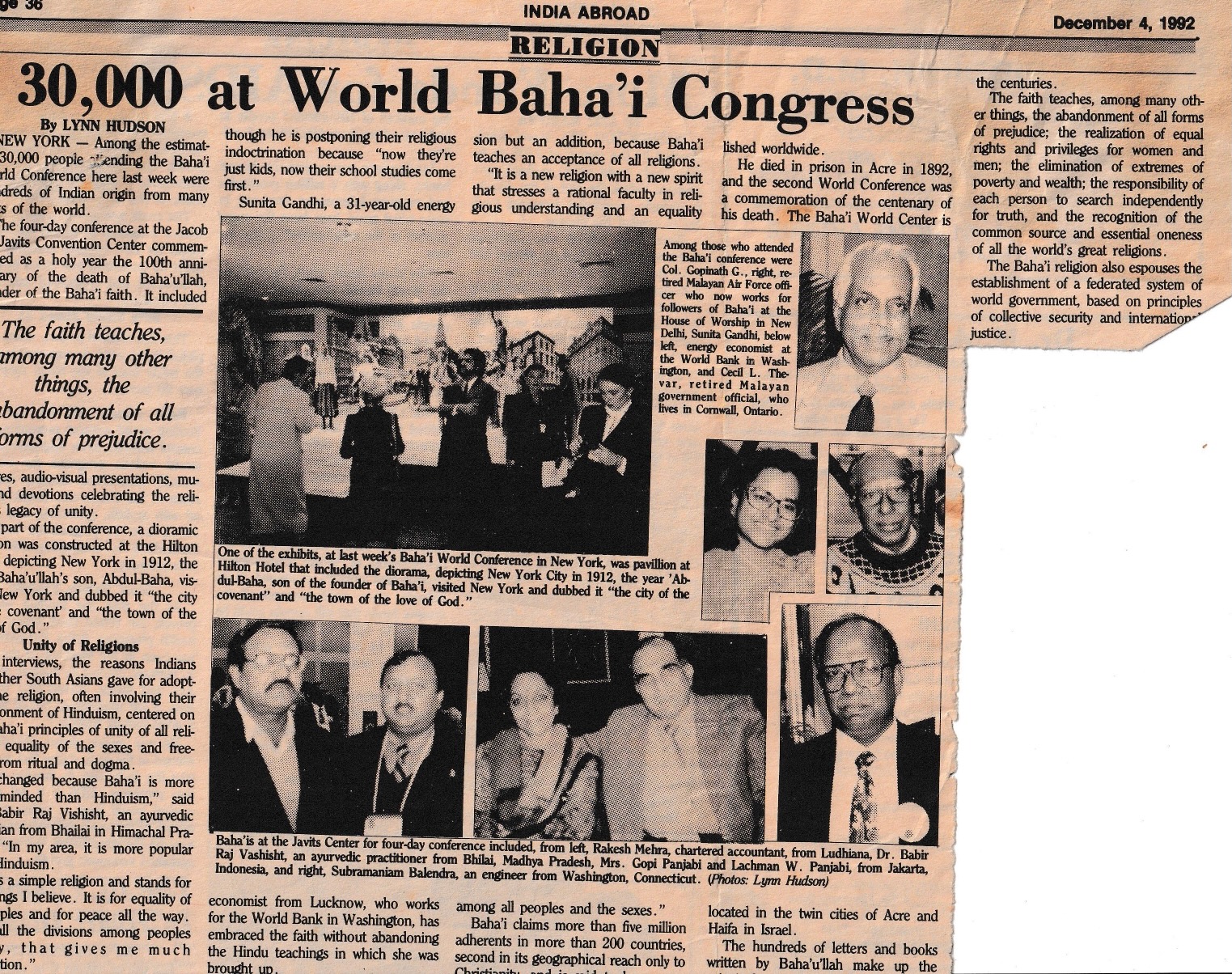 “India Abroad” dated 4 December 1992, gave a huge coverage of the Congress. At the top right is Col Dr. G. Gopinath, a Malaysian believer serving as Director General of the Bahá’í House of Worship in New Delhi, India. (India Abroad is a weekly newspaper published from New York City, which focuses on Indian news meant for Indian American, Indian diaspora and expatriate audience.)
“India Abroad” dated 4 December 1992, gave a huge coverage of the Congress. At the top right is Col Dr. G. Gopinath, a Malaysian believer serving as Director General of the Bahá’í House of Worship in New Delhi, India. (India Abroad is a weekly newspaper published from New York City, which focuses on Indian news meant for Indian American, Indian diaspora and expatriate audience.)
Heeding the call of Amatu’l-Bahá to share with families, friends and colleagues on what they had seen at the Congress, a Regional Bahá’í Congress was organized in Kuala Lumpur, Malaysia with a suitably crafted program. The spirit and joy of the New York Congress was very much prevalent at this Regional Congress.
This was a Congress of a rare kind, the like of which may not be repeated, at least for some time to come. Suffice it to say that the Second Bahá’í World Congress shall forever be etched, with the greatest joy, in the memory of the participants.
A. Manisegaran
31 March 2023
Copyright©bahairecollections.com
You may leave your comments at: info@bahairecollections.com